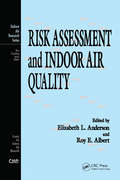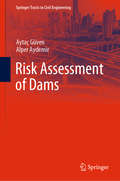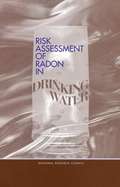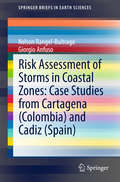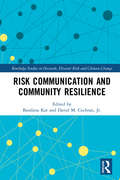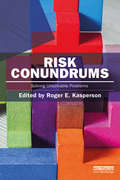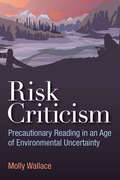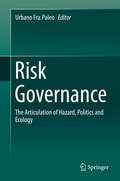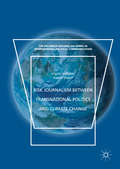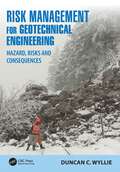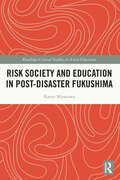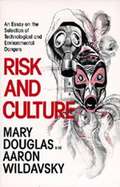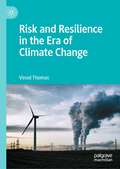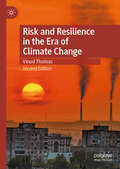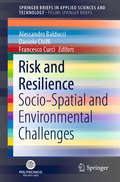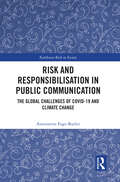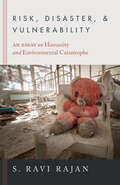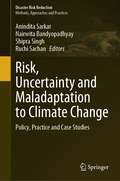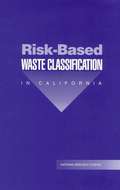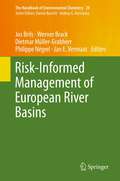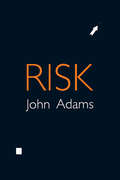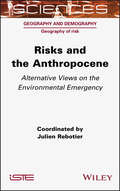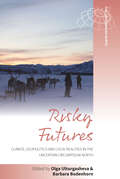- Table View
- List View
Risk Assessment and Indoor Air Quality (Indoor Air Research)
by Elizabeth L. AndersonWith the recent tightening of air quality standards as mandated by the U.S. EPA, has come great pressure on regulatory bodies at all levels of government, along with the industries and groups affected by these standards, to better assess the hazards and risks that result from air pollutants. Risk Assessment and Indoor Air Quality carefully ties tog
Risk Assessment of Dams (Springer Tracts in Civil Engineering)
by Aytaç Güven Alper AydemirThis book offers a timely report on methods for risk assessment procedures for dams, with a special emphasis on dams with small storage dimensions. It starts by introducing all important definitions relating to dams, dam safety, such as the most common failure modes, and risks. In turn, it describes in detail the most important evaluation procedures for various failure modes such as piping, flood, earthquake and stability are described in this chapter. Consequence assessment procedures, together with the different steps of the risk evaluation process, are analyzed, providing a guide on how to identify the appropriate failure mode for the examined dam and setting up the appropriate safety plan. The book introduces the most common methods for predicting peak breach discharge, analyzing some relevant case studies. Upon comparing the findings obtained with the different methods, the book concludes with some general suggestions and ideas for future developments. This book fills an important gap between theoretical works and real-life problems being investigating in practical research studies on dam safety and risk management. It provides readers with the necessary knowledge on risk analysis and shows how to apply this in practice to carry out dam safety studies. It offers practical guidelines to set up risk assessment procedures for different failure modes and predicting failure parameters such as failure time, peak breach discharge and breach width.
Risk Assessment of Radon in Drinking Water
by National Research CouncilThe Safe Drinking Water Act directs the U.S. Environmental Protection Agency (EPA) to regulate the quality of drinking water, including its concentration of radon, an acknowledged carcinogen.This book presents a valuable synthesis of information about the total inhalation and ingestion risks posed by radon in public drinking water, including comprehensive reviews of data on the transfer of radon from water to indoor air and on outdoor levels of radon in the United States. It also presents a new analysis of a biokinetic model developed to determine the risks posed by ingestion of radon and reviews inhalation risks and the carcinogenesis process. The volume includes scenarios for quantifying the reduction in health risk that might be achieved by a program to reduce public exposure to radon.Risk Assessment of Radon in Drinking Water, reflecting research and analysis mandated by 1996 amendments to the Safe Drinking Water Act, provides comment on a variety of methods to reduce radon entry into homes and to reduce the concentrations of radon in indoor air and in water. The models, analysis, and reviews of literature contained in this book are intended to provide information that EPA will need to set a new maximum contaminant level, as it is required to do in 2000.
Risk Assessment of Storms in Coastal Zones: Case Studies from Cartagena (Colombia) and Cadiz (Spain)
by Nelson Rangel-Buitrago Giorgio AnfusoThis book assists the reader in determining storm risks, focussing on sandy coasts and cliff coasts in the context of expected sea level rise from littoral transformation and climate change. It examines storm impacts through matrixes concerning physical parameters, socio-economic activities, ecological and historic resources, and it presents the Coastline Risk to Storms Index as a single numerical measure of the risk for a given area. The methodology is described and tested against two coastal areas: one in the Caribbean Sea (Cartagena, Colombia) and the other on the coast of the Atlantic Ocean (Cadiz, Spain). Both areas record an important flow of tourists associated with the "sun, sea and sand market" which represents an economic recourse for the hinterland too. Chapters describe this approach and explore three particular types of variables: i) the forcing variables contributing to storm-induced erosion, ii) dynamic variables that determine the resilience to erosion (Susceptibility) and iii) the vulnerable targets grouped in three different contexts (socio-economic, ecological and heritage). These are combined into two separate indices, the Hazard Index (combining forcing and susceptibility) and the Vulnerability Index, which together constitute the Coastline Risk to Storms Index. Maps created using this semi-quantitative approximation method can help to determine the causes, processes and consequences of storm-related processes. This book is therefore important to anyone considering coastal development programs, especially decision-makers: the work presented here can assist in the development of preventative management strategies for the most vulnerable areas.
Risk Communication and Community Resilience (Routledge Studies in Hazards, Disaster Risk and Climate Change)
by David M. Cochran Bandana KarRisk communication is crucial to building community resilience and reducing risk from extreme events. True community resilience involves accurate and timely dissemination of risk information to stakeholders. This book examines the policy and science of risk communication in the digital era. Themes include public awareness of risk and public participation in risk communication and resilience building. The first half of the book focuses on conceptual frameworks, components, and the role of citizens in risk communication. The second half examines the role of risk communication in resilience building and provides an overview of some of its challenges in the era of social media. This book looks at the effectiveness of risk communication in socially and culturally diverse communities in the developed and developing world. The interdisciplinary approach bridges academic research and applied policy action. Contributions from Latin America and Asia provide insight into global risk communication at a time when digital technologies have rapidly transformed conventional communication approaches. This book will be of critical interest to policy makers, academicians, and researchers, and will be a valuable reference source for university courses that focus on emergency management, risk communication, and resilience.
Risk Conundrums: Solving Unsolvable Problems
by Roger E KaspersonA risk conundrum can be viewed as a risk that poses major issues in assessment, and whose management is not easily engaged. Such perplexing problems can either paralyze or badly delay risk analysis and directions for progression. Rather than simply focusing on the progress in risk analysis that has already been made, it is crucial to consider what has been learnt about these seemingly unmanageable problems and how best to move forward. <P><P> Risk Conundrums seeks to answer this question by bringing together a range of key thinkers in the field to explore key issues such as risk communication, uncertainty, social trust, indicators and metrics, and risk management, drawing upon case study examples including natural disasters, terrorism, and energy transitions. The initial chapters address risk conundrums, their properties, and the challenges they pose. The book then turns to a greater emphasis on systemic and regional risk conundrums. Finally, it considers how risk management can be changed to address these unsolvable conundrums. Alternative pathways are defined and scrutinized and predictions for future developments set out. <P><P> This book will be of great interest to students and scholars of risk governance, environmental policy, and sustainable development.
Risk Criticism: Precautionary Reading in an Age of Environmental Uncertainty
by Molly WallaceRisk Criticism is a study of literary and cultural responses to global environmental risk in an age of unfolding ecological catastrophe. In 2015, the Bulletin of the Atomic Scientists reset its iconic Doomsday Clock to three minutes to midnight, as close to the apocalypse as it has been since 1953. What pushed its hands was not just the threat of nuclear weapons, but also other global environmental risks that the Bulletin judged to have risen to the scale of the nuclear, including climate change and innovations in the life sciences. If we may once have believed that the end of days would come in a blaze of nuclear firestorm, we now suspect that the apocalypse may be much slower, creeping in as chemical toxins, climate change, or nano-technologies run amok. Taking inspiration from the questions raised by the Bulletin's synecdochical "nuclear," Risk Criticism aims to generate a hybrid form of critical practice that brings "nuclear criticism" into conversation with ecocriticism. Through readings of novels, films, theater, poetry, visual art, websites, news reports, and essays, Risk Criticism tracks the diverse ways in which environmental risks are understood and represented today.
Risk Governance
by Urbano Fra. PaleoThis book explores the common language of politics, ecology and risk, and crosses their conceptual divides. It seeks to shed light on the underlying structural factors, processes, players and interactions in the risk scenario, all of which influence decision-making that both increases and reduces disaster risk. The first section explores risk governance under conditions of increasing complexity, diversity and change. The discussion includes chapters on The problem of governance in the risk society; Making sense of decentralization; Understanding and conceptualizing risk in large-scale social-ecological systems; The disaster epidemic and Structure, process, and agency in the evaluation of risk governance. Part II, focused on governance in regions and domains of risk, includes nine chapters with discussion of Climate governance and climate change and society; Climate change and the politics of uncertainty; Risk complexity and governance in mountain environments; On the edge: Coastal governance and risk and Governance of megacity disaster risks, among other important topics. Part III discusses directions for further advancement in risk governance, with ten chapters on such topics as the transition From risk society to security society; Governing risk tolerability; Risk and adaptive planning for coastal cities; Profiling risk governance in natural hazards contexts; Confronting the risk of large disasters in nature and Transitions into and out of a crisis mode of socio-ecological systems. The book presents a comprehensive examination of the complexity of both risk and environmental policy-making and of their multiple--and not always visible--interactions in the context of social-ecological systems. Just as important, it also addresses unseen and neglected complementarities between regulatory policy-making and ordinary individual decision-making through the actions of nongovernmental actors. A range of distinguished scholars from a diverse set of disciplines have contributed to the book with their expertise in many areas, including disaster studies, emergency planning and management, ecology, sustainability, environmental planning and management, climate change, geography, spatial planning, development studies, economy, political sciences, public administration, communication, as well as physics and geology.
Risk Journalism between Transnational Politics and Climate Change (The\palgrave Macmillan Series In International Political Communication Ser.)
by Ingrid Volkmer Kasim SharifThis book introduces a new methodology to assess the way in which journalists today operate within a new sphere of communicative ‘public’ interdependence across global digital communities by focusing on climate change debates. The authors propose a framework of ‘cosmopolitan loops,’ which addresses three major transformations in journalistic practice: the availability of ‘fluid’ webs of data which situate journalistic practice in a transnational arena; the increased involvement of journalists from developing countries in a transnationally interdependent sphere; and the increased awareness of a larger interconnected globalized ‘risk’ dimension of even local issues which shapes a new sphere of news ‘horizons.’ The authors draw on interviews with journalists to demonstrate that the construction of climate change ‘issues’ is increasingly situated in an emerging dimension of journalistic interconnectivity with climate actors across local, global and digital arenas and through physical and digital spaces of flows.
Risk Management for Geotechnical Engineering: Hazard, Risks and Consequences
by Duncan C. WyllieRisk Management for Geotechnical Engineering: Hazard, Risks and Consequences covers the application of risk management for soil and rock engineering projects, and the preparation of reliable designs that account for uncertainty.The book discusses qualitative risk assessments based on experience and judgement, as well as quantitative risk analysis using probabilistic methods and decision analysis to optimize designs. Many examples are included of how risk management can be applied to geotechnical engineering, with case studies presented for debris flows, rock falls, tunnel stability, and dam foundations. Also discussed are issues of liability insurance and contract law related to geotechnical engineering.This comprehensive book is ideal for practicing geotechnical engineers, addressing the challenges of making decisions in circumstances where uncertainties exist in site conditions, material properties and analysis methods.
Risk Society and Education in Post-Disaster Fukushima (Routledge Critical Studies in Asian Education)
by Kaoru MiyazawaIn response to the explosion of the Fukushima Daiichi power plant in March 2011, this book examines how the concept of a risk society was handled in the various education programs implemented in post-disaster Fukushima. The explosion and subsequent radiation contamination that affected the biosphere of the Fukushima region and beyond, revealed that we live in a risk society. Despite this revelation, official discourses in Fukushima have been geared strictly toward the future, with the aim of restoring communities and resuming development projects. Based on the ethnographic data the author collected in Fukushima between 2013 and 2016, various contested emotions emerged in those education spaces as students and teachers remembered their romanticized and difficult past and dealt with the challenges presented by the risk society in their present lives. The emotionally-charged interactions between past and present also shaped their vision of their future community and of the actions they might take. The dialogues and actions that took places in these education spaces encourage readers to examine the meaning of development and question the basic assumptions and methods of education as society shifts to a risk society. A valuable resource for scholars and students in the fields of globalization and education, curriculum studies, sociology of education, and Japanese studies.
Risk and Culture: An Essay on the Selection of Technological and Environmental Dangers
by Aaron B. Wildavsky Mary DouglasThis research-based book speaks about risks of lapses on environmental conservation and protection endangering the life and security of Americans and the imperative need to wake up and address the issues.
Risk and Resilience in the Era of Climate Change
by Vinod ThomasThis book presents essential insights on the interaction between rising risks and raising the bar for resilience during the climate crisis. Its timeliness lies in applying important findings on risk and resilience to runaway climate change. When risk and resilience are brought together in the context of climate catastrophes, three key messages emerge.The first is that accounting for the root causes of these calamities, and not just their symptoms, is essential to slowing the spike in these events. It is therefore vital to link carbon emissions from human activity to the sharp rise in climate disasters globally. The second is that growth economics and policy must factor in the failure of governments and businesses to tackle spillover harm from economic activities, as seen dramatically with global warming. With climate risks rising, this calls for a fundamental revision in the teaching and practice of business and economics. And third, prevention must become a far bigger part of resilience building, with greater preparedness for more intense destruction built into interventions. This emphasis on prevention deems disaster recovery as not just returning to how things were but building back better.
Risk and Resilience in the Era of Climate Change
by Vinod ThomasThis book presents essential insights on the interaction between rising risks and raising the bar for resilience during the climate crisis. Its timeliness lies in applying important findings on risk and resilience to runaway climate change. When risk and resilience are brought together in the context of climate catastrophes, three key messages emerge. The first is that accounting for the root causes, and not just their symptoms, is essential to slowing these events. It is therefore vital to link carbon emissions from human activity to the sharp rise in climate disasters globally. The second is that growth economics and policy must factor in the failure of governments and businesses to tackle spillover harm from economic activities, as seen strikingly with global warming AND BIODIVERSITY LOSS. With climate risks rising, this calls for a fundamental revision of the framing of growth in the teaching and practice of business and economics. And third, prevention must become a far bigger part of resilience building, with preparedness to avert or handle tougher eventualities built into interventions. Emphasis on prevention deems disaster recovery as not just returning to how things were but building back better.
Risk and Resilience: Socio-Spatial and Environmental Challenges (SpringerBriefs in Applied Sciences and Technology)
by Alessandro Balducci Francesco Curci Daniele ChiffiThis book presents and discusses methodological approaches and operational tools aimed at increasing the awareness and skills necessary to face the social, economic and environmental challenges usually encountered in spatial planning. In addition, it deals with the concepts of risk and resilience from both a theoretical and operational point of view. The book promotes a better understanding of risk, resilience, and related notions such as vulnerability, fragility and anti-fragility in urban and landscape studies, while also analyzing new planning policies. Accordingly, it will benefit all researchers and public decision-makers looking for an interdisciplinary approach to risk and resilience.
Risk and Responsibilisation in Public Communication: The Global Challenges of COVID-19 and Climate Change (Earthscan Risk in Society)
by Antoinette Fage-ButlerThis book explores the connections between risk and responsibilisation in official communication to the public about the global risks of the pandemic and climate change. Our media spheres in the 2020s have been saturated with information about what we should or should not be doing to meet the challenges of the COVID-19 pandemic and climate change. Although the ability of risk communication to ‘responsibilise’ the public is central to its functioning in our societies, this aspect has so far been under-investigated in academia. To address this lacuna, Antoinette Fage-Butler develops a discursive approach to risk communication that focuses on the values that are communicated in risk messages. Examples of official risk communication about the pandemic and climate change from national and transnational contexts are analysed and compared, leading to new empirical findings and theoretical insights about the nature of risk and responsibilisation. Fage-Butler also builds on recent stirrings in the evolving field of risk communication that highlight the importance of cultural and value-related factors. Overall, this book will equip researchers with an approach to risk communication that reflects the complexity of today’s global risk challenges. Risk and Responsibilisation in Public Communication will be of great interest to students and scholars of risk communication, public health and environmental studies.
Risk and Uncertainty Assessment for Natural Hazards
by Jonathan Rougier Steve Sparks Lisa J. HillAssessment of risk and uncertainty is crucial for natural hazard risk management, facilitating risk communication and informing strategies to successfully mitigate our society's vulnerability to natural disasters. Written by some of the world's leading experts, this book provides a state-of-the-art overview of risk and uncertainty assessment in natural hazards. It presents the core statistical concepts using clearly defined terminology applicable across all types of natural hazards and addresses the full range of sources of uncertainty, the role of expert judgement and the practice of uncertainty elicitation. The core of the book provides detailed coverage of all the main hazard types and concluding chapters address the wider societal context of risk management. This is an invaluable compendium for academic researchers and professionals working in the fields of natural hazards science, risk assessment and management and environmental science and will be of interest to anyone involved in natural hazards policy.
Risk, Disaster, and Vulnerability: An Essay on Humanity and Environmental Catastrophe
by S. Ravi RajanOver the course of the past century, there has been a sustained reflective engagement about environmental risks, disasters, and human vulnerability in our modern industrial world. This inquiry has raised a host of crucial questions. Just how safe is humanity in a world of toxic chemicals and industrial installations that have destructive potential? Is it feasible to prevent large-scale catastrophes like the ones in Bhopal, Chernobyl, and Fukushima and smaller-scale disasters such as oil spills and gas leaks? How do environmental hazards affect social and political orders? S. Ravi Rajan expertly synthesizes decades of public policy and academic discourse on how societies measure and ultimately come to terms with risk, danger, and vulnerability and offers a fresh, humanistic perspective for grappling with the new global scale and interconnectedness of these threats.
Risk, Uncertainty and Maladaptation to Climate Change: Policy, Practice and Case Studies (Disaster Risk Reduction)
by Anindita Sarkar Nairwita Bandyopadhyay Shipra Singh Ruchi SachanThis book focuses on integrated disaster risk reduction arising out of climate change and shows how communities build resilience through adaptive and transformative strategies at the local and global levels. It integrates disaster risk, uncertainty, and maladaptation to climate change with evidence from empirical research and a systematic review of existing studies. The book also proposes two important contributions, which makes it distinctive. First, it gives a systematic review of the literature to capture the changing context and concept of risk, uncertainty, and maladaptation to climate change. Second, it uses case studies from around the globe to demonstrate the ways that communities have fostered to build resilience to mitigate the impacts of climate change.There is a growing recognition that decision-makers often rely on intuitive thinking processes rather than undertaking a systematic analysis of options in a deliberative fashion. This latter approach requires accepting a plurality of narratives, embracing multiple disciplinary perspectives, and above all, integrating the appropriate disciplines that can help in finding better solutions. Thus, the book adds value to the existing knowledge on climate change adaptation, perception, and policy initiatives to address disaster risk reduction. It considers all these interconnected issues of risk, uncertainty, and maladaptation through a series of conceptual review- and evidence-based case studies to create new knowledge to address climate change adaptation and a resilient future. The book is a useful contribution to resilience scientists, policymakers, and practitioners from diverse disciplines.
Risk-Based Waste Classification in California
by Committee on Risk-Based Criteria for Non-RCRA Hazardous WasteThe National Academies Press (NAP)--publisher for the National Academies--publishes more than 200 books a year offering the most authoritative views, definitive information, and groundbreaking recommendations on a wide range of topics in science, engineering, and health. Our books are unique in that they are authored by the nation's leading experts in every scientific field.
Risk-Informed Management of European River Basins
by Werner Brack Philippe Négrel Dietmar Müller Jos Brils Jan E. VermaatThe growing impacts of economic activities and climate change on the conditions of rivers throughout the world, require a new, integrated approach towards river basin management, an approach that can also cope with an uncertain future. In this volume, leading European scientists and representatives of major stakeholder groups present risk-informed management as this new approach, as developed in the European Commission-funded project RISKBASE. It aims to improve the ecological quality of river basins and thus to sustain the goods and services they provide for the benefit of society. Risk-informed management involves the integrated application of three key-principles: · Being well informed · Managing adaptively · Pursuing a participatory approach The authors explain and underpin these principles in detail, offer inspiring examples from practice and connect them to the implementation of the European Water Framework Directive (WFD). This book is intended for scientists, consultants and practitioners concerned about river basins, world-wide, as well as the drafters and implementers of the WFD River Basin Management Plans.
Risk: Living With Perils In The 21st Century (Advances In Natural And Technological Hazards Research Ser. #33)
by John AdamsRisk compensation postulates that everyone has a "risk thermostat" and that safety measures that do not affect the setting of the thermostat will be circumvented by behaviour that re-establishes the level of risk with which people were originally comfortable. It explains why, for example, motorists drive faster after a bend in the road is straightened. Cultural theory explains risk-taking behaviour by the operation of cultural filters. It postulates that behaviour is governed by the probable costs and benefits of alternative courses of action which are perceived through filters formed from all the previous incidents and associations in the risk-taker's life.; "Risk" should be of interest to many readers throughout the social sciences and in the world of industry, business, engineering, finance and public administration, since it deals with a fundamental part of human behaviour that has enormous financial and economic implications.
Risks and the Anthropocene: Alternative Views on the Environmental Emergency
by Julien RebotierThe Anthropocene refers to all societies’ current era of environmental challenges. For the social sciences, the Anthropocene represents a historical “moment” with huge potential: it offers people new ways of considering the human condition, as well as how they interact with the rest of the living world and with the planet on all levels. At the turn of the 21st century, the idea of the Anthropocene burst onto the older, diverse and varied scene of risk studies.This “new geological era”, which is entirely created by humanity, went on to revive our understanding of environmental issues, as well as the analysis of the social and political problems that constitute risk situations.Drawing together contributions from specialists in social sciences concerning risks and the environment, Risks and the Anthropocene explores the advantages that the idea of the Anthropocene can offer in understanding risks and their management, as well as the limitations it presents.
Risks, Rewards and Regulation of Unconventional Gas
by Moore Ian G. Grafton R. Quentin Cronshaw Michal C.The global energy transition from carbon-intensive to renewable fuels has increasingly demanded a better understanding of the causes and consequences of the rapid development of unconventional oil and gas. Focusing on key countries including the US, Canada, China, Argentina, the UK and Australia, this book consists of case studies and in-depth analyses that weigh up the risks and rewards at regional, national and global scales. Explaining how and why unconventional fuels are transforming the global energy landscape, the strengths, weaknesses, opportunities and threats are explored through a political, economic and governance-based perspective. Emphasis is placed on how to regulate the industry, encompassing local issues, stakeholder engagement and the social licence to operate. The new baseline studies and standards introduced in this book provide a timely insight into the trade-offs across the social, economic and environmental domains, making this ideal for researchers and policymakers in energy fields, and for graduate students.
Risky Futures: Climate, Geopolitics and Local Realities in the Uncertain Circumpolar North (Studies in the Circumpolar North #6)
by Olga Ulturgasheva Barbara BodenhornThe volume examines complex intersections of environmental conditions, geopolitical tensions and local innovative reactions characterising ‘the Arctic’ in the early twenty-first century. What happens in the region (such as permafrost thaw or methane release) not only sweeps rapidly through local ecosystems but also has profound global implications. Bringing together a unique combination of authors who are local practitioners, indigenous scholars and international researchers, the book provides nuanced views of the social consequences of climate change and environmental risks across human and non-human realms.
